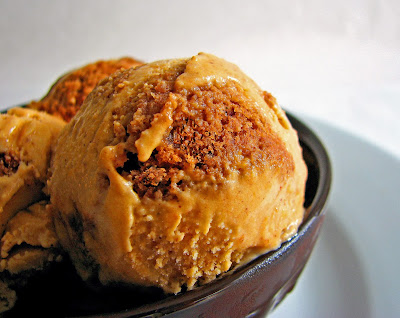
Tamale making is a Christmas tradition in Latin America and in many areas of the West and Southwest, but I’d eat them any time of the year. There are so many versions of tamales from different regions and among different sub-cultures and each are delectable in their own way.
Since I’ve never made tamales before, I thought I’d get into the spirit and put together a dessert tamale that has all the wonderful flavors of Latin America. I've tucked a ganache of earthy rich chocolate, cinnamon, almond and chile powder into a lightly sweetened corn dough or “masa.” The tamales are served with a drizzle of light caramel sauce to finish the plate with a final note of allure.
These tidy little packages deliver a festive combination of flavors from both the New and the Old World. 'Tis the season. ¡Felicidades!

Bench notes:
- I’ve used Maseca brand masa instantanea de maiz since it seems to be widely available.
- To make the ganache, chop the chocolate into very fine bits so the melting process is thorough and even. Once you pour the hot cream onto the chocolate, let it sit for about 2 or 3 minutes, then stir very slowly so you don't cool down the mixture too quickly before all the chocolate has a chance to melt.
- You can make the chocolate filling ahead and refrigerate. The caramel sauce can also be made ahead or while the tamales are steaming.
- For the purposes of planning ahead, it takes about 15 minutes to make the ganache and an hour or so to chill; an hour for the corn husks to soak; about 20-25 minutes to mix the dough; about 45 minutes to 1 hour to assemble; and approximately 2 hours to steam.

Chocolate Caramel Tamales
Makes about 2 dozen tamales
Spicy Chocolate Filling
8 oz bittersweet chocolate, finely chopped
1 C heavy cream
1/2 t ancho chile powder
1/4 t chipotle chile powder
pinch of cayenne
1 t cinnamon
2 T + 2 t honey
3/4 t almond extract
1/2 t vanilla extract
Chop the chocolate into very small fine pieces and place in a bowl.
Gently heat the cream, spices and honey until just before it comes to a boil. Remove from heat, stir in the extracts and pour over the chopped chocolate. Let it sit for a couple of minutes.
Using a rubber spatula, gently and slowly stir the center and then slowly work out in concentric circles. Blend until there are no streaks and the mixture is smooth. Pour into a clean container and cool completely. Cover and refrigerate for an hour or two until firm.
Corn “Masa” (Dough)
24 corn husks
1 C water
1 C milk
1/2 t salt
1/2 t cinnamon
1/8 t freshly ground nutmeg
1 t vanilla
2 C Maseca masa instantanea de maiz
7 oz (14 T) butter @ room temp
1/3 C brown sugar
1 t baking powder
Soak the corn husks in large bowl of very hot water for 30 minutes. Weight them down with a heavy bowl or saucepan to keep them submerged. Once they are softened, separate the husks carefully to avoid tearing. Continue to soak in hot water until pliable, up to 30 minutes more. Drain and pat dry.
Bring the water, milk, salt, cinnamon and nutmeg to a slow simmer. Remove from heat and add vanilla. Gradually stir in the masa harina until it forms a very thick dough.
Cream the butter, sugar and baking powder until very light and fluffy, about 3 to 5 minutes. Add the masa harina dough in small walnut-sized pieces, one or two at a time. When all the dough has been added, continue beating until it is smooth, fluffy and light, about 6 to 8 minutes. You can test to see if it’s ready by taking about a tablespoon of the dough and placing it in a glass of warm water. It should float.
Place a dry corn husk on a clean work surface. Spread about a 1/4 C of the dough into the center lower half of the corn husk, leaving the upper half with the pointed tip free of any ingredients. Take about a tablespoon of the chocolate ganache, elongate it and place on top. Fold the long sides of the corn husk over filling, then fold the pointed tip over the filled half. Lay seam side down. Repeat the process until all the corn husks are filled.
Arrange a steamer rack in large stockpot and add water to just below bottom of the steamer rack. Cover and bring water to boil.
Place the tamales upright in the steamer, loosely leaning against one another. Lower heat to a simmer, cover and steam until dough is firm to touch and separates easily from the husk, about 1 1/2 to 2 hours. Keep a close eye on the water level to be sure there is enough throughout the steaming process.
Brown Sugar Caramel Sauce
3 oz (6 T) butter
1 C firmly packed brown sugar
1/2 C + 2 T heavy cream @ room temperature
1/4 t salt, to taste
1 t vanilla extract
Melt the butter in a saucepan and add the sugar. Cook without stirring for about 2 minutes to dissolve and caramelize. Then, whisking constantly, add the cream and salt and continue cooking and for another 2 minutes. Remove from heat and add the vanilla. Add more salt to taste.

















































